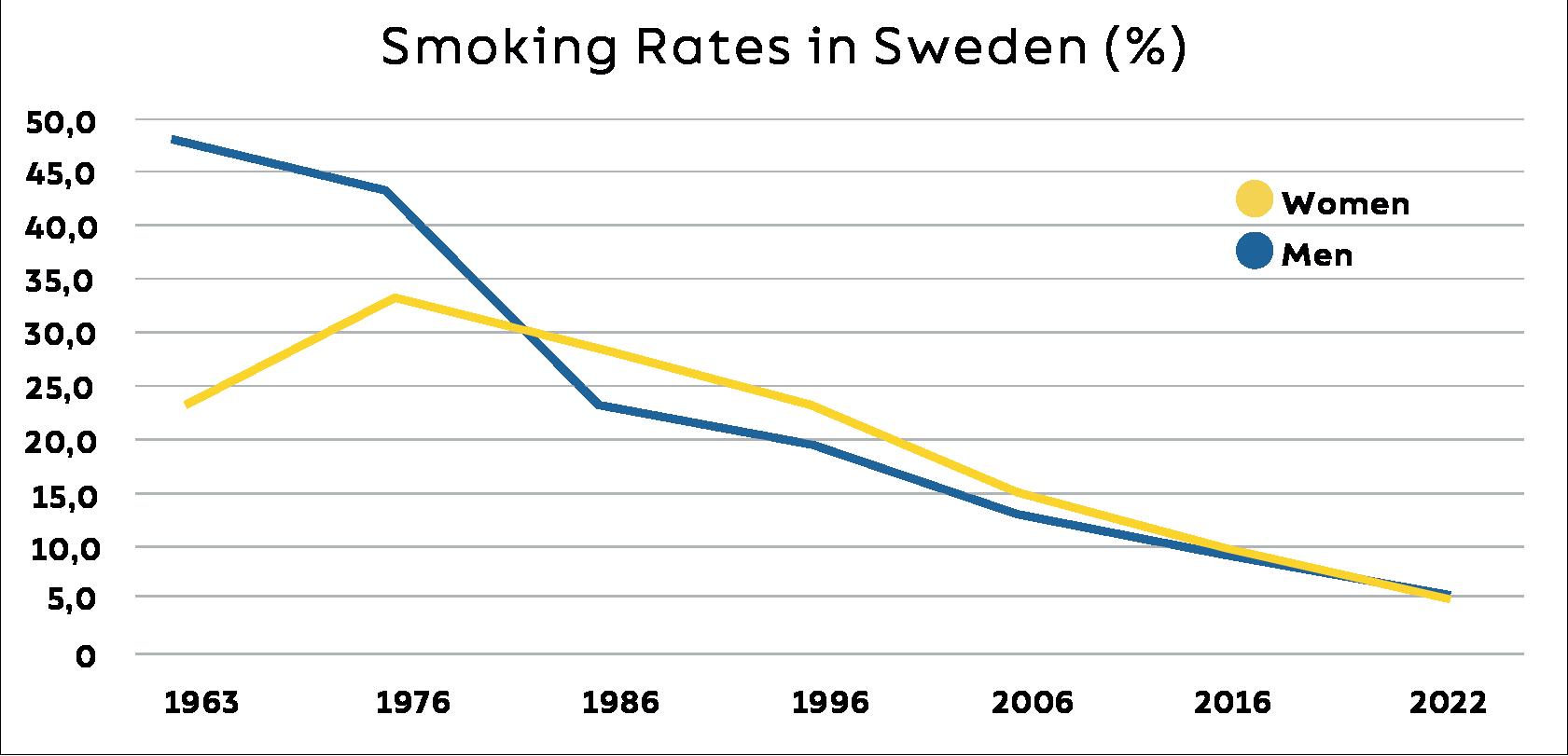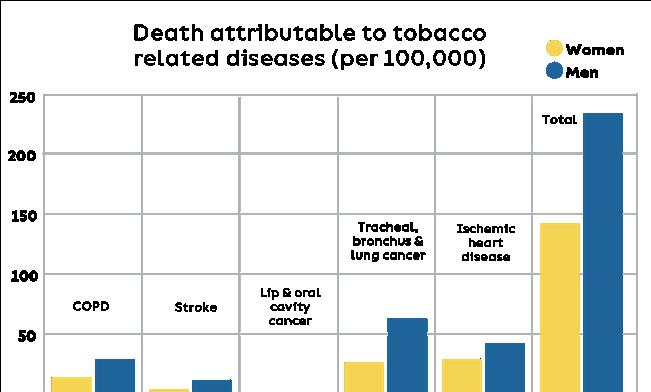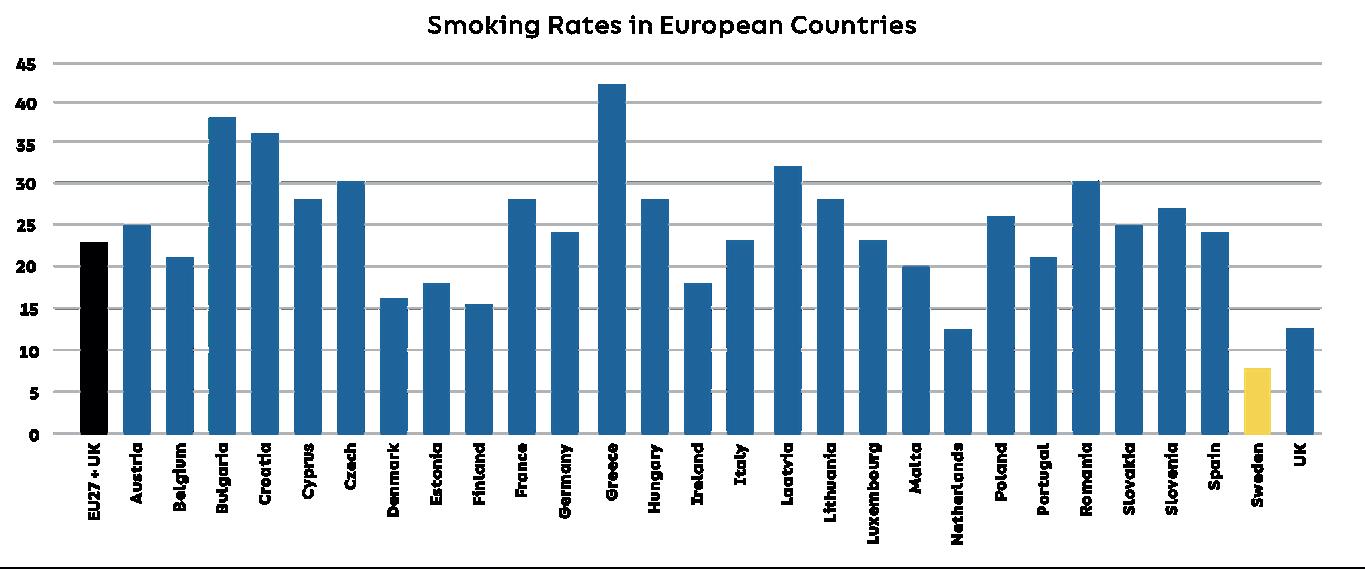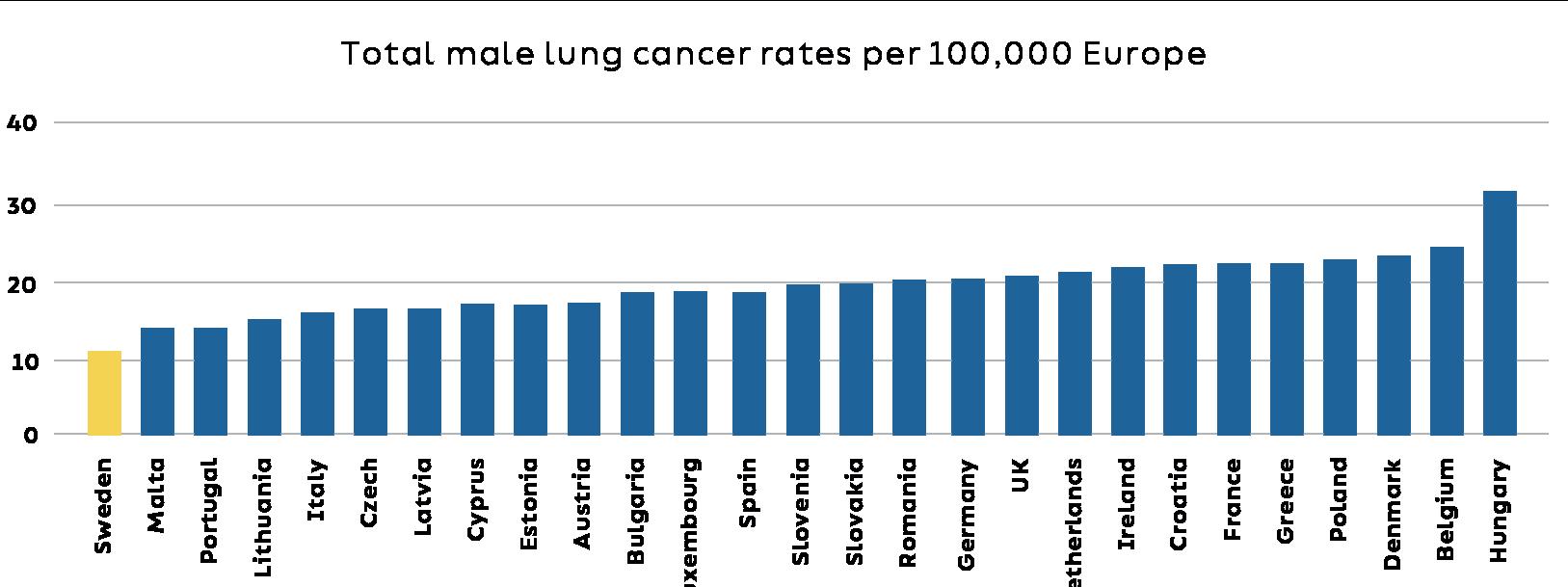
8 minute read
Science Today
SMOKE FREE SWEDEN 2023; A ROADMAP TO A SMOKE FREE SOCIETY
Smoking cigarettes or other combustible tobacco products is the biggest cause of noncommunicable deaths in the world. According to the World Health Organization (WHO), eight million deaths were attributable to tobacco in 2017(1). Yet there remain more than one billion smokers in the world today, despite the health risks of smoking being widely known. The bulk of tobacco-related illness and death is ultimately caused by the inhalation of toxic smoke from combustible cigarettes into the lungs(2). Nicotine, while addictive, has not been proven to be the direct cause of diseases or health damage, such as lung cancer, stroke, and chronic obstructive pulmonary disease (COPD)(3).
Advertisement
For several decades now, reducing the risk associated with tobacco consumption has been a central issue for different health authorities worldwide, such as in countries like the United Kingdom, Germany, and New Zealand, which have a strategy of focusing on the use or consumption of reduced risk options by the smoking population, such as heated tobacco, snus and electronic nicotine delivery systems or vapes.
Recently Sweden, a country with a population of just over ten million will, based on current trends, soon become the first nation to give up cigarette smoking. Both the European Network for Smoking and Tobacco Prevention (ENSP) and the World Health Organization (WHO) consider countries to be officially smoke free when less than 5% of the adult population smokes tobacco.

Source: Figures post 2012, The Public Health Agency of Swede, Use of tobacco and nicotine products (self-reported) by age, gender and year Pre 2012 extracted from Karl Fagerstrom, The case of snus.
The European Union (EU) has tasked all its Member States with becoming ‘smoke free’ by 2040. Barring a dramatic shift in progress, most will miss this target by some distance. Sweden, however, will achieve this historic milestone as soon as this year - 2023. That is an incredible 17 years ahead of the EU target date and before every other nation in the bloc is even within sight of the achievement.
To obtain such a result, Sweden has proactively implemented what the WHO Framework Convention on Tobacco Control (FCTC), Article 1 (d) suggests: “tobacco control” means a range of supply, demand and harm reduction strategies that aim to improve the health of a population by eliminating or reducing their consumption of tobacco products and exposure to tobacco smoke. By employing strict tobacco control measures, the consumption of combustible tobacco products was made less attractive for adult smokers, while facilitating the use of less harmful noncombustible forms of tobacco and nicotine. Because of this, Sweden has always had lower smoking rates than the rest of Europe. Key to Sweden’s tobacco control success was embracing harm reduction strategies, thereby creating a realistic and replicable roadmap to a smoke-free world.
During the last five decades, the Swedes have progressively and systematically made smokeless and less harmful alternatives to cigarette smoking accessible, affordable, and acceptable to their population. In supporting these smoke free options such as snus and, in recent years, oral nicotine pouches and electronic systems for nicotine administration (otherwise called vape products), their pragmatic, enlightened approach has delivered public health gains. In fact, a study by the Swedish Institutet för Tobaksstudier, or Institute for Tobacco Studies, using data from the WHO’s 2012 Global Report on Mortality Attributable to Tobacco, concluded that if other EU countries practiced the same tobacco consumption patterns as Sweden, no fewer than 355,000 lives per year could have been saved.

Source: Global Burden of Disease Database, 2019.
Source: Global Burden of Disease Database, 2019.
Results:
Over the past 15 years, Sweden has slashed its smoking rates from 15% in 2008 to 5.6% today(4).
The EU’s average smoking rate is currently 23%almost five times higher than Sweden’s. In many EU countries, one in three people still smokes(5).
Sweden’s incidence of cancer is 41% lower than the rest of its European counterparts, corresponding to a 38% lower level of total cancer deaths(6).
24 of the other 27 EU Member States have a tobacco-related mortality rate twice as high or more than Sweden relative to population size(7).
Sweden has a 39.6% lower rate of death of all tobacco-related diseases compared to the EU average. Sweden is one of the three countries with the lowest number of deaths attributed to lung cancer(8).
With a smoking level of only 3% in those aged 1629 years, Sweden boasts the lowest level of youth smoking in Europe(9).
The International Multi-Stakeholder Study Group on Smoke Free Sweden will be engaging widely to elicit more views and insights to better understand Sweden’s success. Nonetheless, Sweden’s experience tells us that the following steps are key to driving considerable reductions in smoking prevalence:

Source: European Commission, Special Eurobarometer 506, 2021.
1. Fundamental differentiation between combustible and non-combustible forms of tobacco and nicotine: recognition of the evidence that smoke free alternatives are genuinely less harmful and pose fewer risks than smoking, combined with support and encouragement for smokers, who cannot or will not quit, to switch.
2. Risk differentiation between various forms of tobacco and nicotine products: the Swedish Government has recently requested the recognition and mapping of the “relative risk” of all tobacco and nicotine product categories. This could facilitate the provision of more accurate risk communication to consumers, allowing smokers to better understand the relative risk and more carefully choose the smoke free product that is most effective for them. The gold standard remains, of course, that consumers quit all forms of tobacco and nicotine altogether.
3. Access to smoke free alternatives to cigarettes: tobacco control measures alone are not sufficient. Access to smoke free alternatives is critically important. In Sweden, snus, oral nicotine pouches, e-cigarettes and heated tobacco are all available, and can be bought both on and offline.

Source: WHO International Agency for Research on Cancer, Estimated age-standardized incidence rates (World) (2022)
4. Educating the public on the smoke free alternatives: no product is risk-free but being able to achieve a risk reduction of 95% or higher will translate into significant benefits for smokers who quit. Smokers need access to evidence-based information about better alternatives to smoking, especially in view of a spate of misinformation about their safety. For example, a recent survey conducted in the United Kingdom found that two thirds of smokers believed e-cigarettes to be just as harmful as cigarettes, despite evidence showing they are at least 95% less harmful.
5. Consumer acceptance: smoke free alternatives must also be genuinely acceptable to smokers as a better alternative to cigarettes. For this to be the case, products need to be satisfying and capable of being smokers’ first preference –which means ensuring a range of flavours and nicotine concentrations for consumers to buy. In a nutshell, there is a need for clear differentiation between the treatment of cigarettes and alternative products that make it easier for smokers to switch.
6. Affordability: policy settings should support the adoption of reduced harm, smoke free alternatives by making them more affordable than the most harmful combustible cigarettes. This means low or no excise on smoke free alternatives, which in turn eliminates financial barriers to switching away from cigarettes.
Taken together, these learnings will help countries struggling to beat smoking. It is our view that if the policies and approach of Sweden are replicated, countries around the world will be able to become smoke free, just as Sweden has done. Governments around the world have implemented tobacco control measures, yet they have struggled to further reduce stubbornly high smoking rates. In order to make further progress and to achieve a smoke free society, other policies must be considered.
Dr. Delon Human

President and CEO of Health Diplomats, a specialized health, nutrition and wellness consulting group operating worldwide. He has acted as adviser to three WHO Directors-General and to the UN SecretaryGeneral on global public health strategies.
Karl-Olov Fagerström, PhD

Swedish psychologist at the University of Uppsala, ex-Editor in Chief for Journal for Behaviour Therapy; specialist in the fight against smoking. Co-author, The Swedish Experience: A Roadmap for a smoke-free society.
References
World Health Organization (2019), WHO global report on trends in tobacco smoking 2000-2025. third edition.
Abrams, D., Glasser, A., Pearson, J. Villanti, A., Collins, L., and Niaura, R. (2018). Harm Minimization and Tobacco Control: Reframing Societal Views of Nicotine Use to Rapidly Save Lives, Annual Review of Public Health. From: https://doi.org/10.1146/annurevpublhealth040617-013849
Benowitz, N. L., Hukkanen, J., & Jacob, P., 3rd (2009). Nicotine chemistry, metabolism, kinetics and biomarkers. Handbook of experimental pharmacology, (192), 29–60. From: https://doi.org/10.1007/978-3-540-69248-5_2
The Swedish Public Health Agency, Use of tobacco and nicotine products (self-reported) by age, gender and year, 2022.
Special Eurobarometer 506: Attitudes of Europeans towards tobacco and electronic cigarettes (v1.00). (2021). European Commission, Directorate-General for Communication. From: http://data.europa.eu/88u/dataset/S2240_506_ENG
Ramström, L. (2020). Institute for Tobacco Studies. Death rates per 100,000 attributable to tobacco – Sweden and the rest of the EU in 2019. Compiled from The Global Burden of Disease Study. DOI - 10.13140/RG.2.2.29008.12806
Snus Commission (2017) Snus saves lives: A study of snus and tobacco-related mortality in the EU.
Eurostat (2019) Cancer Statistics - Specific Cancers.
Global Burden of Disease Database, (2019)










